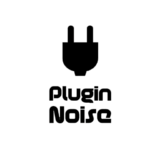From mind-bending sound design to limitless patching, these 20 modular and semi-modular synth VST plugin picks bring the Eurorack experience to your DAW with no required desk space (or life savings).
If you’ve ever stared at a spaghetti mess of patch cables on a modular synth and thought, “This is either a masterpiece in the making or the fastest way to fry my CPU,” then you’re in the right place. Modular and semi-modular synths have always fascinated me. They turn the sound design into a playground where happy accidents and weird sonic discoveries happen all the time.
But as much as I love the tactile joy of twisting knobs and repatching cables, my bank account (and available desk space) strongly disagrees with the idea of owning a massive Eurorack setup. That’s why I turn to modular and semi-modular synth plugins.
They give me the same patching freedom, deep sound design possibilities, and mind-bending modulation options, without the need to take out a second mortgage. Plus, in the digital realm, I never have to worry about accidentally patching something wrong and sending my speakers into a full-scale existential crisis.
Of course, software doesn’t fully replace the feel of real hardware, but it comes with some killer advantages: total recall, unlimited patch cables, and no risk of stepping on your most expensive module (yes, I have done this).
I wrote this article to share some of my favorite modular and semi-modular synth plugins, the ones that deliver insane flexibility, gorgeous sound, and workflow-friendly designs. Whether you’re deep into West Coast synthesis, love a good subtractive bass, or just want to create bleeps and bloops that make your cat question your life choices, there’s something here for you.
1. Native Instruments Reaktor 6

If modular synthesis is the sonic equivalent of building a spaceship from scratch, then Reaktor 6 is like having an entire NASA lab at your fingertips, minus the risk of blowing anything up.
You could use it as a DIY sound design sandbox, where you can build your own instruments, samplers, and effects from the ground up. Or, if you’re feeling a little less mad scientist, you can dive into its Blocks system, which turns modular patching into a far less intimidating (but still wildly powerful) experience.
- Vast Workflows Possibilities
One of the best things about Reaktor 6 I love is the sheer depth of control, which lets you build a synth from scratch with custom oscillators, filters, and modulation sources. Or, if you need granular synthesis tools that can stretch your audio into oblivion, you can do that, too.
Just want to load up a preset and pretend you did all the work? Absolutely. Plus, with 70+ factory instruments and an insane user library, you’ll never run out of inspiration.
- Top-tier sound quality
I became a fan of its DSP, zero-delay feedback filters, and pristine oscillators, as Reaktor 6 can potentially deliver everything from lush pads to screaming basslines with ridiculous precision if you know your machine right.
And to get more hands-on, it also plays nice with MIDI, OSC, and even CV/Gate, meaning you can connect it to external modular gear.
Native Instruments Reaktor 6 is compatible with Windows 10 or 11 and macOS 11, 12, or 13 operating systems and is available in VST, AU, and AAX plugin formats.
2. Arturia Buchla Easel V
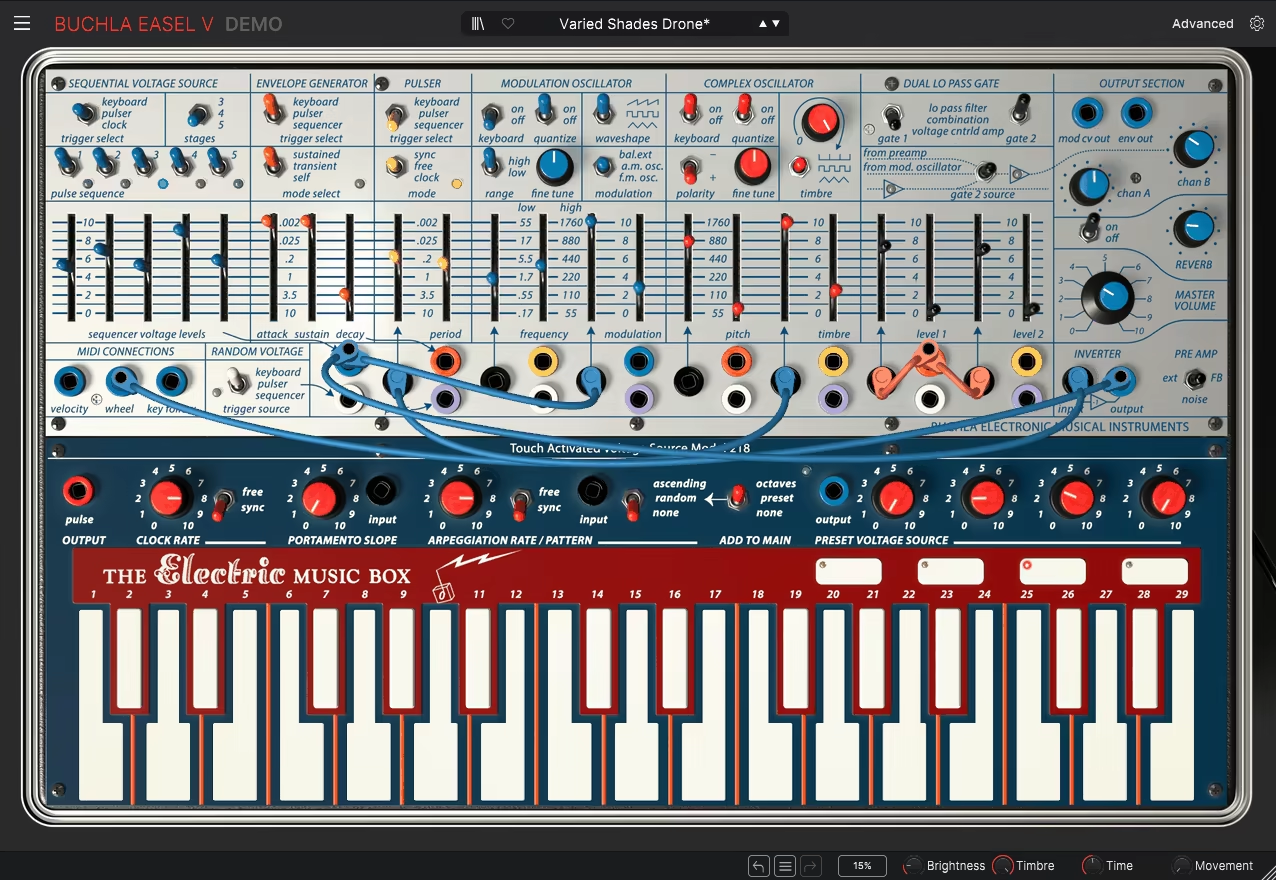
Buchla Easel V can be your ticket to the “West Coast synthesis” and recreates Don Buchla’s legendary Music Easel.
I will start off by describing how much I love how Easel V faithfully recreates the original touch-sensitive Model 218 keyboard, complete with polyphonic capabilities and even an arpeggiator. Its dimensions of touch, combined with MIDI compatibility, bring expressive control to your fingertips.
- Complex Oscillator
The heart of the Buchla Easel V is the Complex Oscillator, capable of generating harmonically rich tones through techniques like wavefolding. By folding a waveform’s peaks and valleys back on themselves, I was able to produce unique, textured sounds ranging from delicate to downright abrasive.
- Seamless Patching
The click-and-drag patch bay is intuitive and clean, keeping patch cables out of your way. Modulation sources are color-coded, while inputs remain black, making it easy to experiment without losing track of your signal flow.
- Modulation at Every Turn
With the Modulation Oscillator, you can dip into both AM and FM synthesis to sculpt everything from gentle shifts to metallic, clangorous textures. You can use it as an LFO or dial it up to audio range for even more modulation possibilities.
- Sequential Voltage Source
This is where things get truly experimental. Acting like a sequencer for modulation, the Stepped Voltage Source features five steps and multiple trigger options, allowing you to dynamically control up to 76 modulation targets across the instrument.
Arturia Buchla Easel V is available in standalone, VST, AAX, Audio Unit, and NKS plugin formats and is compatible with Mac OS 11+ and Windows 10+ operating systems.
3. Softube Modular
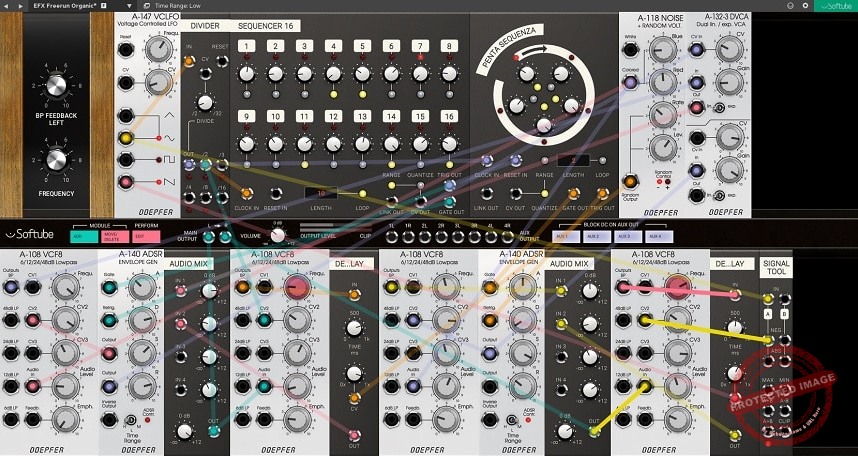
If Reaktor 6 is the DIY modular laboratory, Softube Modular is like walking into a perfectly curated Eurorack store.
It is a faithful emulation of a Eurorack environment, featuring officially licensed modules from Doepfer, Intellijel, and Softube’s own Heartbeat drum modules, giving you a legit modular system inside your DAW.
- Sonically wide
At its core, Softube Modular ships with a solid selection of classic Doepfer modules, including VCOs, filters, VCAs, envelopes, LFOs, and a noise/random generator, all modeled in collaboration with Doepfer to nail the original circuitry’s character. If that’s not enough, an expanding marketplace of premium add-on modules lets you go deeper into the West Coast, East Coast, or other diverse sonic territories, too.
- Analog Characteristics
Softube Modular holds well against real hardware with rich, analog-modeled oscillators, punchy envelopes, and characterful filters. The 48dB/oct super filter and its sound were quite impressive, offering multiple slopes, deep resonance, and drive options that can push your sound from clean to full-on acid meltdown. With audio-rate modulation, you can go even crazier with FM movements, filter squelching, and evolving textures.
While it delivers sound, Softube Modular wasn’t the lightest on my CPU, especially when running at low latencies. The scaling and UI workflow could also be smoother, especially when managing complex patches. I would recommend Softube an update for 20225.
Softube Modular is compatible with Windows 10 or later and Monterey 12, Ventura 13, and Sonoma 14 operating systems and is available in VST, VST 3, AU, and AAX plugin formats.
4. Arturia Modular V3
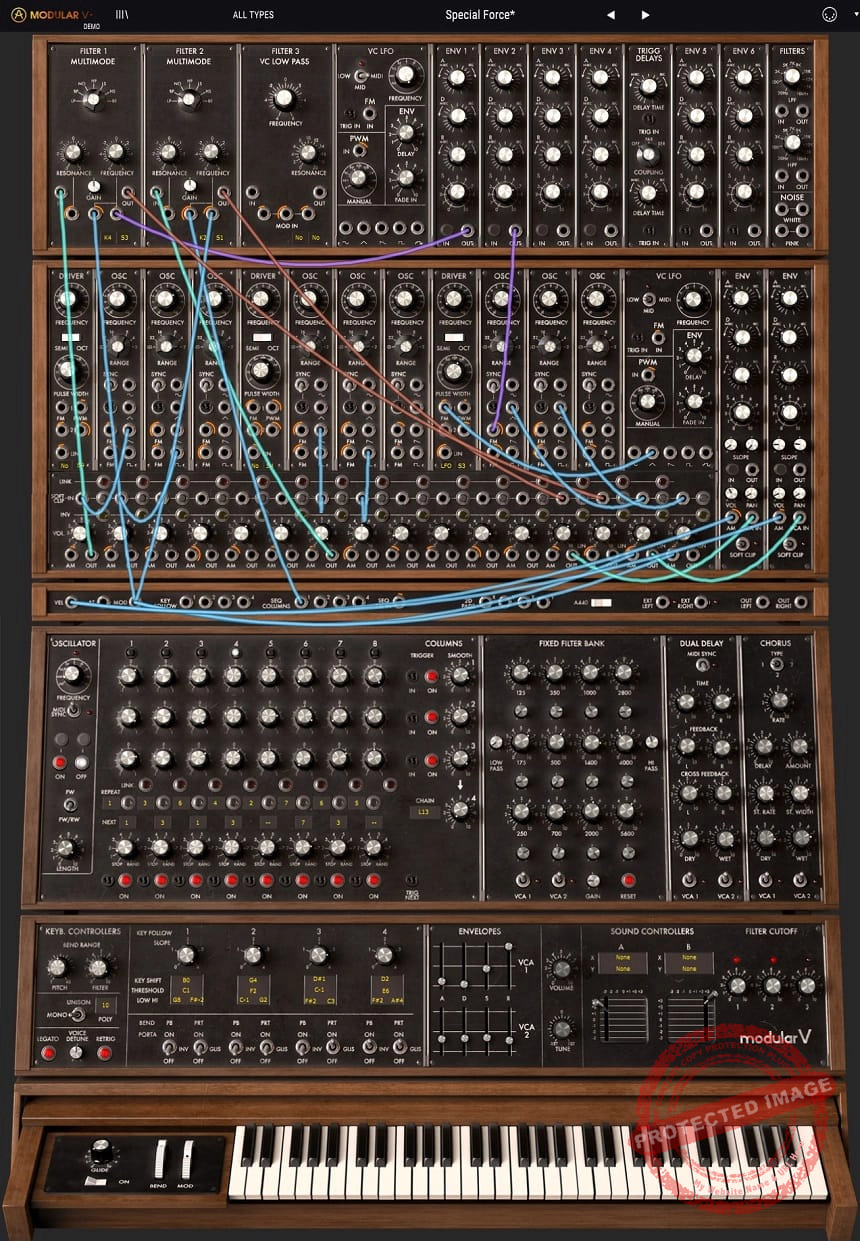
Some synth plugins give you futuristic sound design tools, while others are time machines. Arturia Modular V3 falls firmly into the latter category and captures the magic of the legendary Moog 55, 35, and 15 systems.
Arturia didn’t just slap a “Moog-like” filter onto a generic synth engine. Instead, they went deep. The oscillators, filters, VCAs, and envelopes are modeled after the original circuits, preserving the quirks and organic feel of classic analog synthesis.
- Elaborate Setup Potential
The 16-channel mixer makes grouping oscillators a breeze, and the fully modular architecture means you can patch together intricate signal paths just like the real deal. You go to the extent of even nine oscillators running in sync, modulating each other into oblivion.
Overall, you get 9 oscillators, 3 filter slots, 6 envelopes, 2 LFOs, 2 VCAs, and 1 noise generator. 9 oscillators do seem intimidating to me, too, even after practicing modular synthesis for quite some time now.
- External Hardware Integration
Beyond its vintage charm, Modular V3 offers modern conveniences. MIDI integration lets you map parameters to external controllers, a built-in three-row (24 steps) step sequencer makes crafting evolving patterns effortless, and the fixed filter bank, dual delay, and chorus modules add depth and movement. You also get a 12-stage phaser along with a ring modulator.
It even has a drop-down menu option for patching, so if you’re not in the mood for digital cable spaghetti, you can keep things tidy. That said, Modular V3 isn’t a perfect clone. The oscillator phase resets with each key press, which removes some of that unpredictable analog drift. Envelope retriggering also behaves differently than on vintage Moogs, affecting how sounds evolve in a performance.
Arturia Modular V3 is compatible with Windows 10 or 11 and macOS 11+ operating systems and is available in VST, AU, and AAX plugin formats.
5. VCV Rack
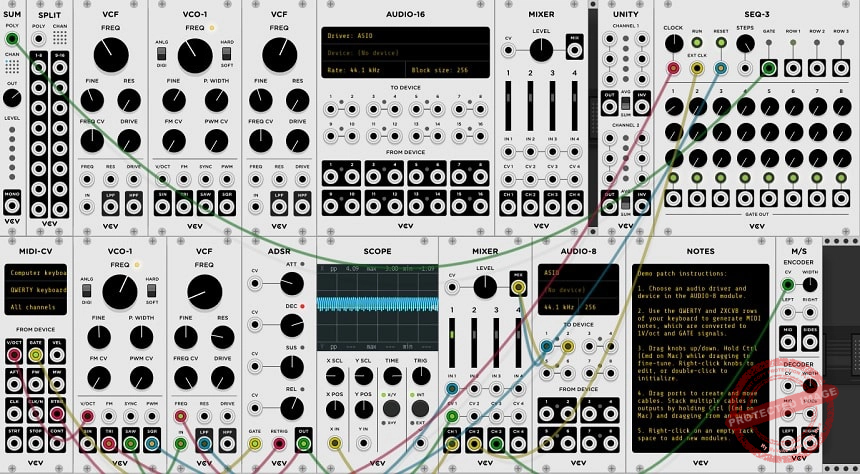
If you’ve ever wanted to dive into modular synthesis but hesitated at the thought of hemorrhaging cash or losing precious desk space, VCV Rack offers an open-source, free modular synthesizer solution that brings the chaotic creativity of a Eurorack setup in a digital setting.
The beauty of VCV Rack lies in its flexibility, which lets you keep it simple with a few oscillators and filters or create an intricate and self-evolving patch. Its library is stacked with officially licensed recreations of modules from renowned brands like Mutable Instruments, Befaco, and more.
You get a total of 2000 modules that you can patch together everything from analog-modeled oscillators to quirky experimental sequencers, with many modules available for free. Want to recreate the legendary Clouds granular processor? VCV Rack has it. Need a top-tier reverb like Plateau? You’re just a couple of clicks away.
- Polyphonic Patching
Many of VCV Rack’s modules support polyphony, allowing you to create lush, chordal patches without additional effort. With just a few tweaks, you can turn a monophonic subtractive synth into a multi-voice masterpiece.
- Modular Effects and External Integration
Not only can VCV Rack process audio through its countless modules (think filters, reverbs, delays, and distortions), but it can also interface with your external hardware synths or MIDI controllers, so you can turn your guitar, microphone, or favorite synth as triggers for modular synthesis.
- A True Modular Learning Experience
Building a patch in VCV Rack mimics real-life modular synthesis, teaching you the fundamentals of oscillators, filters, VCAs, envelopes, and LFOs. Its drag-and-drop interface and color-coded cables make the learning curve approachable, even for beginners.
- Fully Customizable Workflow
You can create patches as simple or complex as you’d like. Start with a single oscillator and build up to massive, generative systems with self-evolving sounds. There’s no “right way” to patch, which means VCV Rack encourages creativity and experimentation.
Also, the fun lies in its paid expansions. While the base program is free, premium modules and expansions from third-party developers let you dive deeper into advanced synthesis techniques. Popular packs can let you integrate modules for FM synthesis, wavefolding, and more complex sequencing.
One thing I experienced with VCV is that its modules can vary in quality, and documentation isn’t always consistent. Additionally, CPU usage can get hefty when running polyphonic patches or large setups, so you might need to fine-tune things for optimal performance.
VCV Rack is available in VST2, VST3, Audio Unit, CLAP, and standalone plugin formats and is compatible with Linux, Windows, and Mac operating systems.
6. u-he Bazille
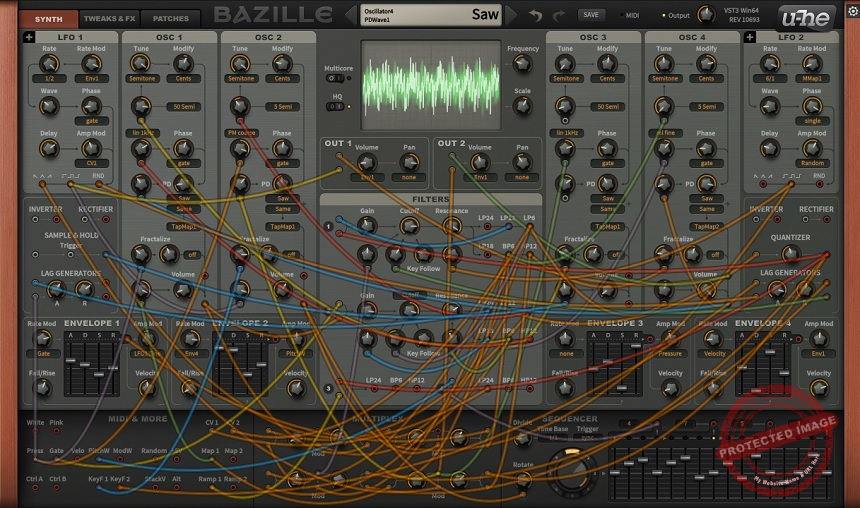
u-he Bazille is like an ultimate 1,000-piece puzzle set designed for sound designers and patching enthusiasts.
Bazille offers a powerhouse of modular features, combining digital oscillators, analog-modeled filters, and unique modulation tools to create a complex yet exciting virtual modular system.
- Digital Oscillators with Analog Filters
Its oscillators are digital, built on Phase Distortion (PD) and Frequency Modulation (FM) synthesis, which gives it this sharp, edgy sound that can cut through any mix. But here’s the twist: when you run those digital oscillators through Bazille’s analog-modeled filters, they somehow take on this warm, rich character.
- Sound Starts mutable as LFOs
I also found Bazille’s four oscillators to be quite powerful. They don’t just spit out your standard sine, square, or saw waves but can create all kinds of evolving, chaotic sounds, thanks to features like Fractal Resonance. The “Fractalize” knob is like a wildcard for your sound, as it takes tame waveforms and turns them into unpredictable monsters. I’ve used it to make gritty basslines, screaming leads, and even ambient textures that feel alive. The oscillators can also drop into LFO mode, which means you can turn them into modulators and get these wild audio-rate modulations.
- Multimode Filters
The multimode filters in Bazille are just as versatile as the oscillators. I love that they can self-oscillate and have up to six outputs each, which means I can route multiple variations of the filtered signal to different parts of my patch. Sometimes, I’ll use a filter to clean up a sound, but other times, I crank up the resonance and let it scream.
- Patching That’s Actually Fun
I’ve used a lot of modular synth plugins, and Bazille’s patching system is one of the most intuitive. Everything is drag-and-drop, and since the inputs and outputs are clearly labeled, it didn’t take me long to start experimenting. One of my favorite moments was the first time I created a feedback loop using the Multiplex module. I was just playing around, but it resulted in this swirling, evolving pad that I couldn’t stop listening to.
The Multiplex modules are especially fun, they let you mix, crossfade, and modulate signals in ways I didn’t even think were possible.
u-he Bazille is available in VST2, VST3, Audio Unit, CLAP, and standalone plugin formats and is compatible with Linux, Windows 7 or later, and Mac OS 10.10 or newer operating systems.
7. Cherry Audio CA2600 Synthesizer
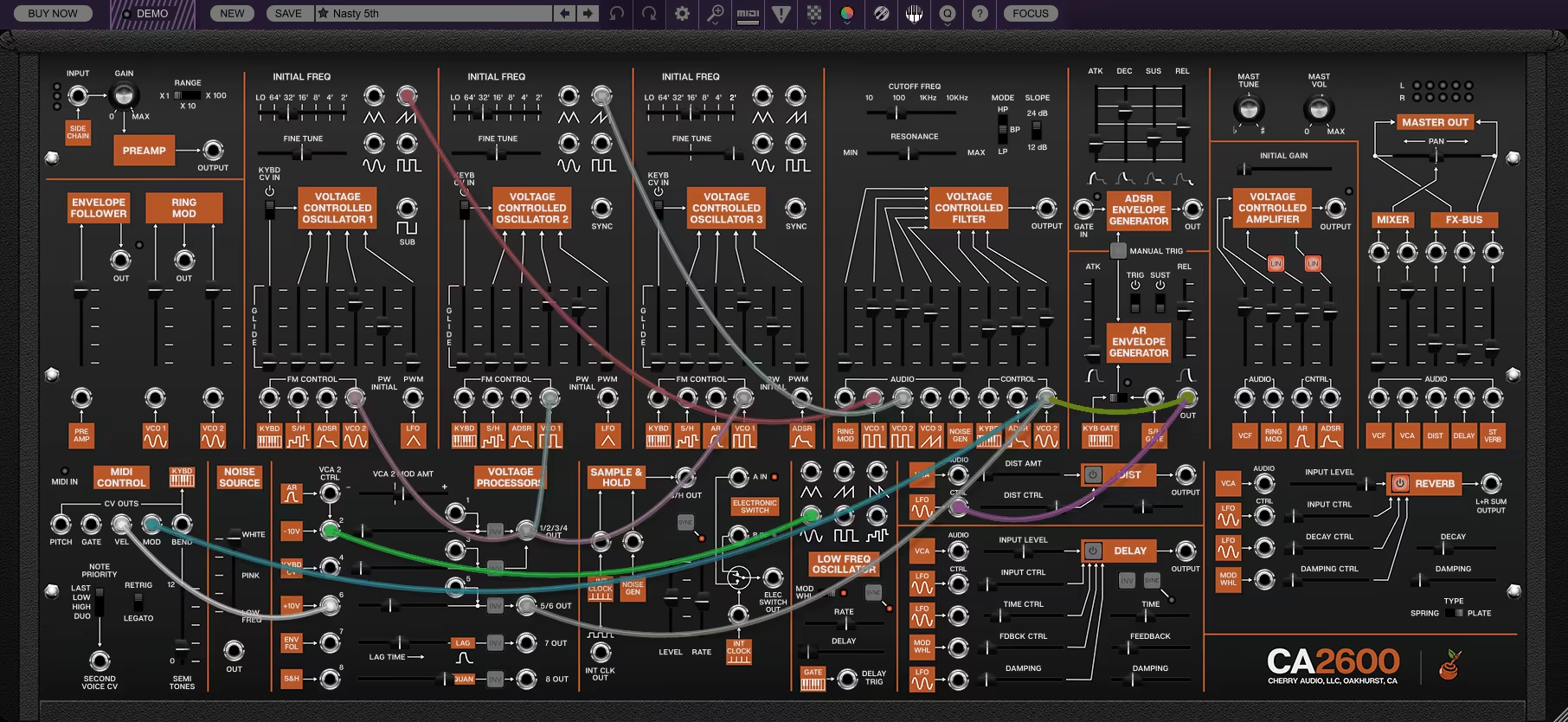
The CA2600 modular VST Synthesizer is a duophonic synth inspired by the classic ARP 2600.
From the quirky oscillator waves to the ladder-style filter and even the external audio input and preamp section, Cherry Audio has gone all-in to replicate the classic analog sound.
But I would not call it a copy, but see it as an evolution. With semi-normally patch cables, built-in effects, and an intuitive interface where everything is right in front of you, the CA2600 offers a hands-on experience that feels like having a piece of vintage hardware without headaches.
- Integrated Effects
Built-in distortion, reverb, and delay (all CV-controllable) let you add depth and character to your sounds without relying on external plugins. The delay syncs perfectly with your project tempo, making it a breeze to craft rhythmic patterns.
- Fully Modular, Without the Overwhelm
The advanced patch panel keeps everything within easy reach. Features like quick patching for rapid routing and unlimited mults per jack mean you can experiment endlessly without getting bogged down. And for beginners, its semi-normalled connections give you a solid starting point with no need to patch just to get sound.
- Enhanced Modulation Options
The addition of an LFO with six waveforms and tempo sync gives you even more modulation power, letting you create pulsating rhythms or evolving textures. Plus, the Voltage Processors section includes an extra VCA and a 1/2-step quantizer, which is suitable for more precise pitch control and sequencing.
- Flexible Filters
The synth’s multi-mode filter has both 12dB and 24dB slopes, offering everything from smooth, subtle filtering to aggressive resonance.
Cherry Audio CA2600 is available in VST, VST3, AU, AAX, and standalone plugin formats and is compatible with macOS 10.13 or above and Windows 7 or above operating systems.
8. Kilohearts Phase Plant (Semi)

Kilohearts Phase Plant is a semi-modular softsynth. What makes it so special is its open modular architecture, which gives you the potential to create literally any sound you like.
Unlike traditional synths with fixed setups: two oscillators here, an envelope there, Phase Plant lets you add as many sound generators, effects, and modulators as your CPU can handle.
- Build the Synth of Your Dreams
Phase Plant allows you to design from scratch. You can combine analog-modeled oscillators, wavetables, samples, and noise generators into a single patch. With an advanced Wavetable Editor, you can shape your own wavetables or use the factory library to layer and sculpt your sounds.
- Unlimited Modulation Possibilities
The modulation system in Phase Plant is one of the best I’ve ever used. You can connect envelopes, LFOs, random generators, and more in endless configurations. You can do everything from modulating the speed of an LFO with another LFO to creating chaotic, generative textures. Every parameter is ready to be modulated!
- FM Like You’ve Never Seen Before
Phase Plant takes Frequency Modulation (FM) to the next level. You can cross-modulate or even self-modulate any generator’s frequency, phase, or volume. That results in wild, gnarly tones and textures that rival the sound design flexibility of a fully modular synth rig.
The visual representation of waveforms, modulation, and signal flow becomes essential with this plugin and works really well for it. I can see exactly what’s happening in my patch as I work, which makes the whole process faster and more intuitive.
I’ve used Phase Plant for everything from thick, detuned basses to delicate, evolving soundscapes. One of my favorite patches involved layering a wavetable oscillator with a filtered noise generator, routing them through separate delay and reverb lanes, and modulating the filter cutoff with a slow-moving LFO.
Kilohearts Phase Plant is available in VST, VST3, AU, AAX, and standalone plugin formats and is compatible with macOS and Windows operating systems.
9. Madrona Labs Kaivo
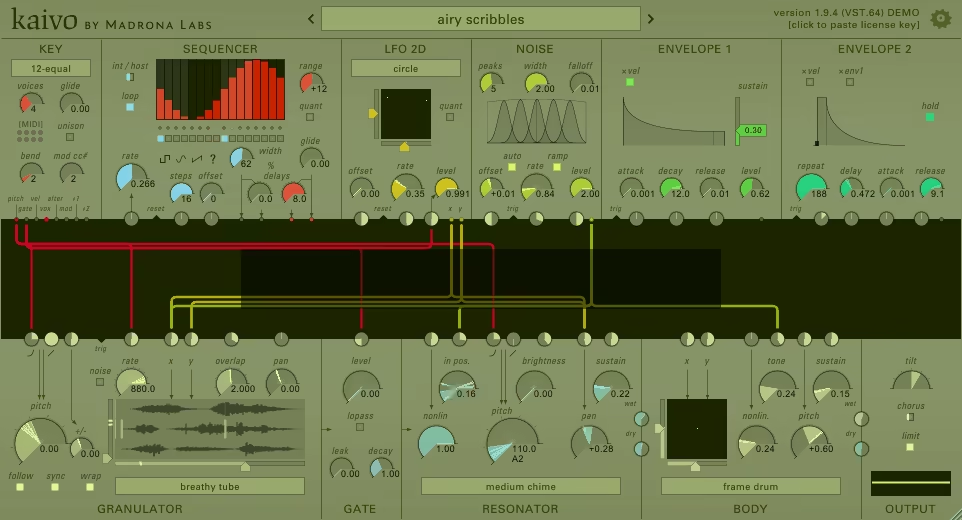
Kaivo merges granular synthesis, which breaks sound into tiny grains, with physical modeling, simulating resonant objects’ behavior. This pairing allows for incredibly rich, detailed, and lifelike sounds, yet it’s equally suited for abstract, experimental textures.
Madrona Kaivo’s granulator takes audio input, divides it into grains, and feeds it into a resonator, essentially the “physical object” of the synth. From here, the resonator transforms the sound using finite difference time domain (FDTD) algorithms, simulating the physical properties of strings, springs, and plates. The result is a sound design experience that bridges the gap between digital and organic.
- Expansive Modulation Options
Kaivo’s semi-modular interface makes it easy to connect modulation sources and create dynamic, evolving sounds. Every parameter, from pitch to brightness to resonator position, is modulable, allowing for complex interactions and wildly expressive patches.
One of my favorite features is the way Kaivo’s granulator and resonator interact. I once fed a simple, plucked sample into the granulator and routed it through the gut string resonator. By modulating the resonator’s pitch with an LFO, I ended up with a rich, evolving sound that felt both organic and futuristic, something you’d expect to hear in a sci-fi movie soundtrack.
The spatial controls are another highlight. I love being able to pan different elements independently, which adds an incredible sense of depth to my patches. Whether I’m designing ambient drones or glitchy sound effects, Kaivo always delivers.
- Realistic Instrument Bodies
Kaivo takes things a step further with its physical body models, which simulate how sound behaves in different materials. Choose from wooden bodies, a metal plate, and a frame drum. These 2D models even have spatialized left and right pickups, letting you control how sound flows through them for a more immersive experience.
- Eight Tuned Resonators
Kaivo comes with eight resonator types, each with its own sonic character:
-
- Strings (metal, nylon, gut)
- Chimes (small, medium, large)
- Springs (small and large)
Madrona Labs Kaivo is compatible with Mac OS 10.9 or higher and Windows 7 or higher operating systems and is available in AU and VST plugin formats.
10. Tracktion Hyperion
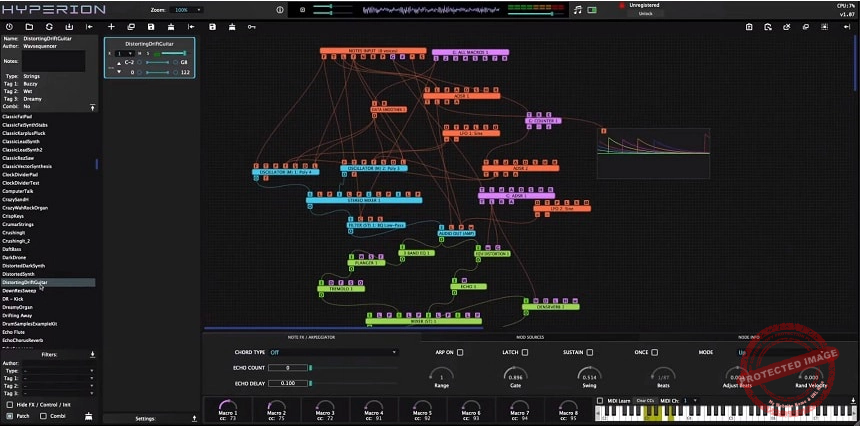
I added Tracktion Hyperion to this list for its deep capabilities and 16 polyphonic layers, allowing you to design complex soundscapes, intricate patches, and multi-timbral arrangements.
Each layer in Hyperion acts as its own modular patch, complete with unlimited nodes and individual arpeggiators, giving you unparalleled control over every aspect of your sound.
- Multi-Layered Synthesis
The first time I used Hyperion, I was struck by how quickly I could build multi-layered patches. I started with a simple pad on one layer, added an arpeggiated FM lead on another, and routed their outputs to a shared reverb layer for a cohesive sound. The process was smooth and intuitive, even with all the modular options available.
Hyperion lets you create up to 16 independent layers, each with its own synthesis setup, effects chain, and MIDI controls. Layers can be split by key range, velocity, or MIDI channel, making it easy to create complex, multi-timbral patches. You can even enable MPE (MIDI Polyphonic Expression) for some layers while keeping others traditional.
- Diverse Synthesis Options
Hyperion combines diverse synthesis methods, including virtual analog with unison detuning and wave shaping, 4-operator FM synthesis with 12 algorithms, and 32-step wave sequencing with smooth crossfades. It also features physical modeling (plucked strings, flutes), sample playback with looping and SFZ/SF2 import, and vector synthesis for mixable sources and effects processing.
- Modular Patch Design
Each layer’s modular environment is incredibly flexible. With over 150 node types, you can build patches using oscillators, filters, modulators, logic nodes, and effects. The drag-and-drop interface makes it easy to visualize and connect nodes, while tooltips and visual feedback keep everything intuitive.
Tracktion Hyperion is available in AU and VST3 plugin formats and is compatible with macOS 10.13 or later and Windows 8 operating systems.
11. Cherry Audio Voltage Modular
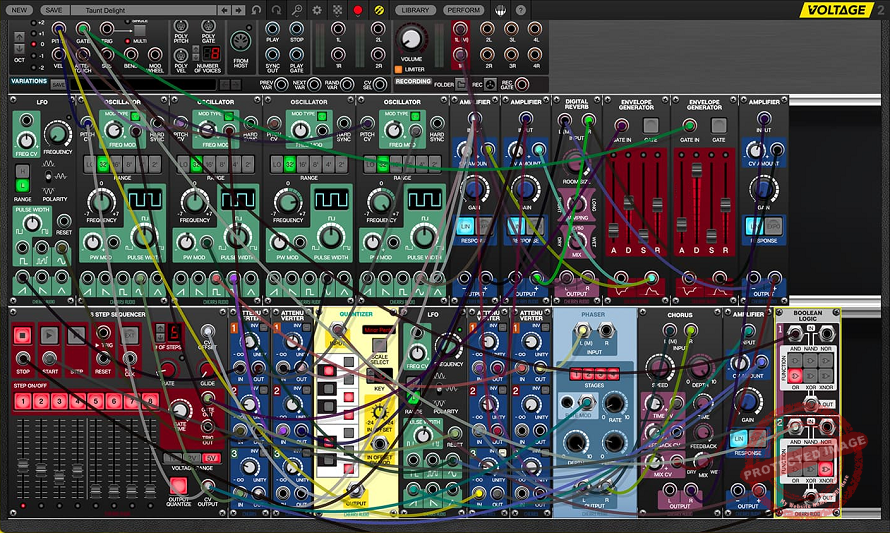
Voltage Modular 2 modular synth plugin eliminates many of the obstacles found in other modular environments, offering features like unlimited patch cables, clean cable management, and a customizable interface.
It removes restrictions on how you can connect your modules. Every jack supports unlimited cables, so you’re free to experiment with complex modulation setups without running out of connection points. Additionally, the innovative Busses feature lets you send modulation or audio across your patch without cluttering the interface with excessive cables.
One of my favorite aspects of Voltage Modular is its balance between depth and accessibility. As someone who enjoys modular synthesis but doesn’t want to deal with the spaghetti-like mess of cables, I found the clean patching system and Busses feature to be incredibly helpful. It’s easy to focus on sound design without getting bogged down by cable clutter.
- Variations for Dynamic Creativity
The new Variations feature is a game-changer for modular synthesis. You can save unlimited variations of a patch and trigger them in real time using MIDI, CV, or other controls. That makes it easy to create evolving sounds, dynamic performances, and sequences that shift on the fly.
I used it in a live performance to cycle through evolving patches, triggering new layers and modulations with a MIDI controller. It felt dynamic and fresh, something I wouldn’t have achieved with traditional hardware.
- Built-In Recording
Voltage Modular 2 includes a built-in recording section in the IO Panel, allowing you to capture pristine 32-bit floating-point audio directly from the software.
- Highly Expandable Library
Voltage Modular features an innovative in-app store where you can purchase and instantly install new modules and presets. With over 800 available modules, you can tailor your modular environment to suit your needs. Whether you want classic analog-style oscillators, unique effects, or complex sequencers, there’s a module for every purpose.
Cherry Audio Voltage Modular is available in VST and AU plugin formats and is compatible with macOS 11 or above and Windows 7 or above operating systems.
12. Loomer Aspect 2 (Semi)
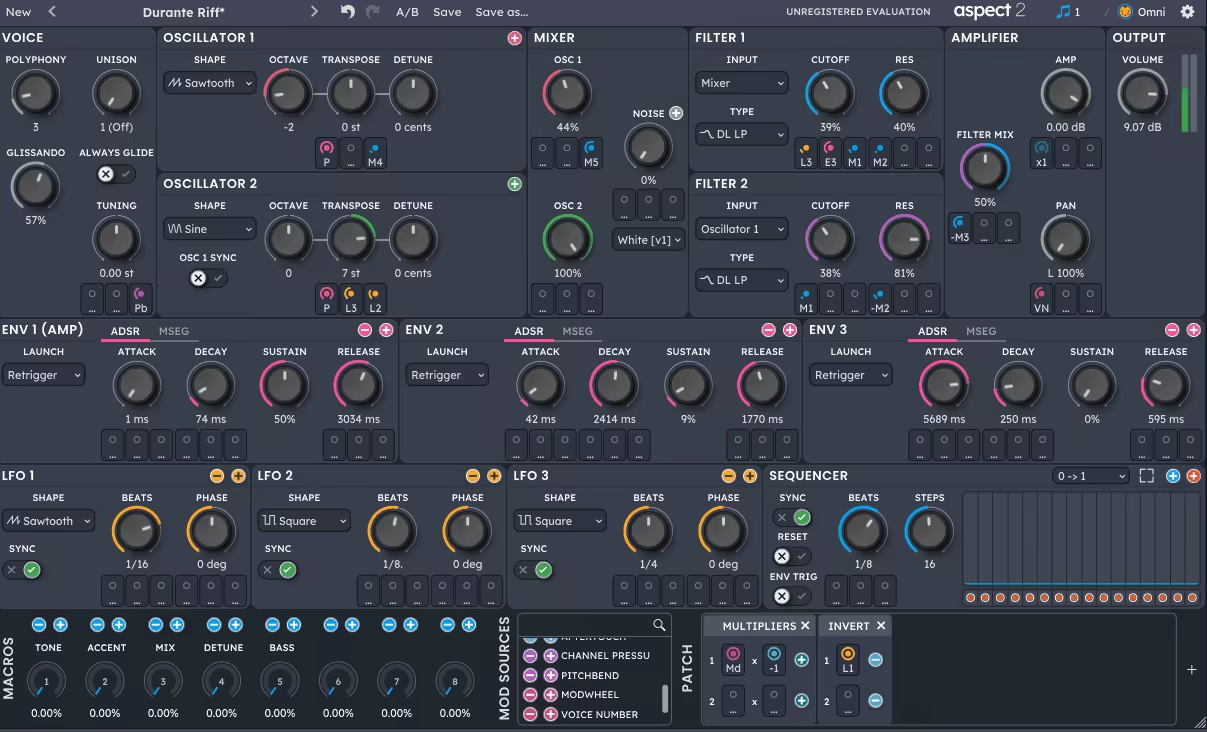
Loomer Aspect 2 brings the power of semi-modular synthesis to your fingertips, offering a seamless combination of analogue-modelled sound and a highly intuitive interface.
With drag-and-drop routing, you can easily connect modulation sources and destinations without messy cables. Audio sources can act as modulators, and modulations can double as audio sources, opening up endless creative possibilities.
- High-Quality Sound Engine
At the heart of Aspect 2 are two analogue-modelled oscillators capable of generating raw, powerful waveforms. I like combining them with dual filters, which thankfully give me the freedom to route them in series, parallel, or blended to create unique sonic textures.
- Advanced Modulation Options
Aspect 2 also includes three envelopes, three multi-segment envelope generators (MSEGs), and three LFOs that can run freely or sync to tempo. The modulation architecture is incredibly flexible, allowing you to combine sources using tools like quantizers, lag generators, and sample-and-hold modules.
I was also impressed by the 600 factory presets, which let you start your creative journey with a vast library of expertly crafted sounds, ranging from rich pads to complex experimental textures. With MIDI Learn, total parameter automation, and a scalable, resizable interface in three color schemes, I can use Aspect 2 for both Live and Studio purposes.
Loomer Aspect 2 is available in VST 2/3, AU, AAX, and standalone plugin formats and is compatible with Windows Vista or later, Mac OS 10.9 or newer, and Linux operating systems.
13. u-he Zebra2
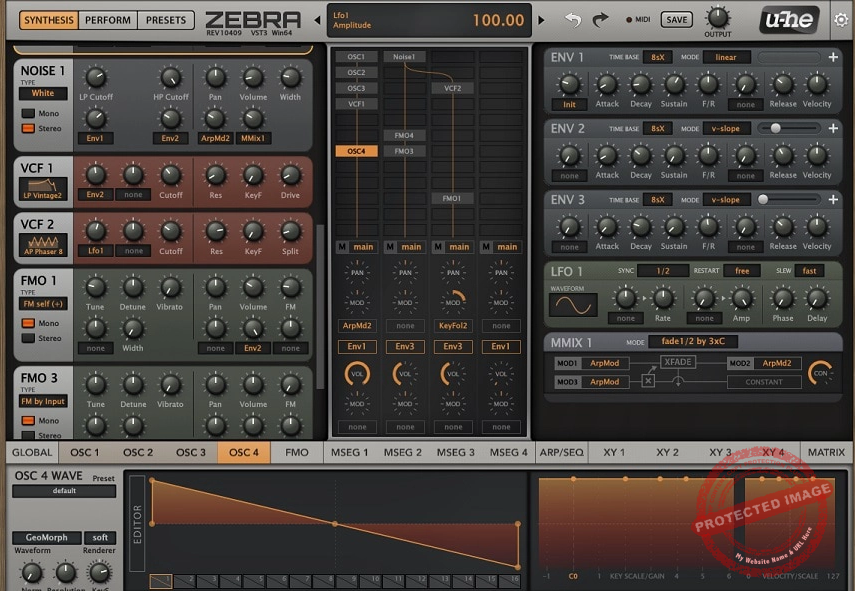
Whether you’re producing cinematic scores, electronic music, or experimental textures, Zebra2 modular synth VST plugin offers endless possibilities with its versatile sound design workflow and its ability to combine additive, subtractive, wavetable, and FM synthesis into one modular playground.
Zebra2 has a “wireless modular” design, which lets you build patches without the usual cable clutter. You drag and drop modules into a central grid, routing them in a top-to-bottom signal flow. It’s like having a modular synth without the headache of physical patch cables, giving you a clean, intuitive, and highly flexible workflow.
The oscillators are particularly impressive. Each one offers features like waveform stacking (up to 11 voices), pulse width modulation, hard sync, and an OSC FX section packed with 48 spectral effects. I’ve enjoyed hours shaping some interesting and “mad” tones using these tools, which can be best described as “experimental.”
- Four Oscillators and Advanced Modulation
The four wavetable oscillators are incredibly flexible, and with four FM oscillators and up to 32-segment envelopes, you can create sounds that evolve and breathe. It features 12 modulation slots, but every module also has assignable knobs, making it easy to create intricate, dynamic patches.
One of my favorite things about Zebra2 is how quickly it lets me get creative. The grid-based patching makes experimentation effortless. Recently, I used its comb filters to simulate plucked string resonances and layered that with its FM oscillators for a dynamic, hybrid sound. The results were stunning, and the process felt seamless.
Then there are also the X/Y Performance Pads, which allow for up to 16 simultaneous parameter controls, which is fantastic for live tweaking or expressive sound design.
- Stellar Effects & Performance Suite
The 21 onboard effects, including two reverb options, delay, EQ, and more, are all modulate-able. For example, I love routing an LFO to reverb size for evolving ambient textures. Moreover, its 16-step sequencer with customizable step modulation is perfect for rhythmic, evolving patterns.
u-he Zebra2 works with DAWs that support CLAP, AUv2, VST2, VST3, and AAX plugin formats and Mac OS X 10.10 or newer, Linux, and Windows 7 or newer operating systems.
14. Cherry Audio PS-3300

When I first fired up Cherry Audio’s PS-3300, I knew I was in for something special. This virtual synthesizer captures the essence of one of the rarest and coolest polyphonic analog synths ever made, the Korg PS-3300 from 1977.
The PS-3300’s three independent signal generator panels immediately caught my attention. Each one acts as its own polyphonic synthesizer, complete with oscillators, filters, envelopes, resonators, and LFOs. This setup gives you an insane amount of flexibility. Think of three synths in one, all working together or independently.
- Deep Sound Design Potential
I found the triple resonators also quite useful, as they are suitable for crafting rich, vocal-like textures and sweeping, otherworldly tones. With per-note tuning, you can dive into alternate temperaments like Just Intonation or Mean Tone, opening up microtonal possibilities that go far beyond standard synth fare.
For me, the semi-modular architecture was also a standout feature, whose virtual patch cables make complex routing easy. Cherry Audio’s thoughtful touches, like customizable cable colors and unlimited miles per jack, keep everything tidy. The included studio-quality effects, such as a lush reverb and tempo-synced echo, add polish without requiring extra plugins.
- Readymade sounds
I would also like to mention its 360+ factory presets, which give you various sounds, from rich pads to gnarly leads, showcasing the PS-3300’s potential. I’ve also enjoyed diving into the Legacy presets, which replicate the original Korg patch sheets for a taste of synth history.
Cherry Audio PS-3300 is compatible with DAWs that support AU, VST, VST3, AAX, and standalone plugin formats and works with macOS 10.13 or above and Windows 7 or above operating systems.
15. Madrona Labs Aalto
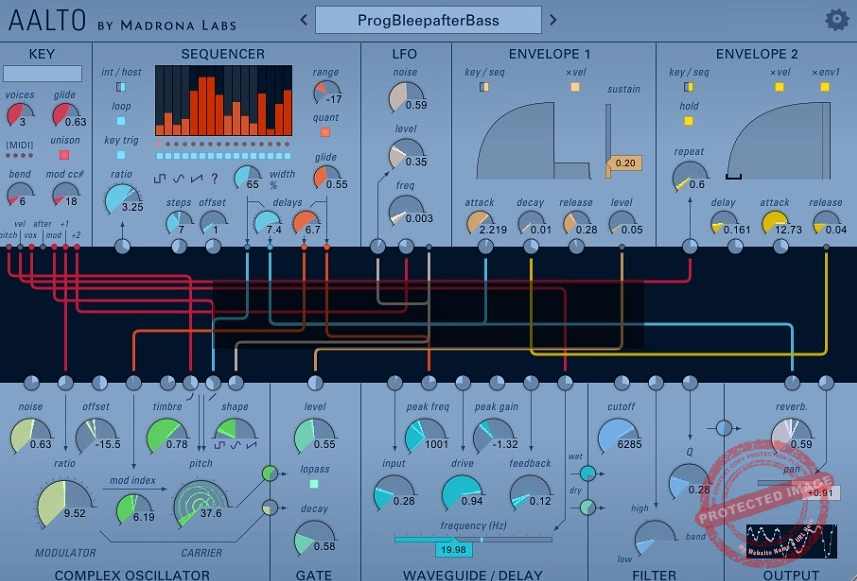
Aalto is a semi-modular synthesizer inspired by Don Buchla’s designs.
At its core, Aalto features a complex oscillator with FM, timbre, and waveshape controls, giving you access to an expansive palette of tones, from smooth and lush to gritty and edgy. Unlike many synths that rely on static wavetables, Aalto’s dynamic calculation ensures every sound feels vibrant and organic.
- Dynamic Sound Engine
Aalto’s sounds are generated through dynamic calculation instead of static wavetables, ensuring a lifelike and organic tonal quality. Inspired by Don Buchla’s designs, the oscillator includes FM, timbre, and waveshape controls, offering unparalleled versatility for crafting expressive sounds.
- Create movement
The lowpass gate is another highlight. With its vactrol emulation, you can dial in a natural, ringing response or opt for instantaneous precision. Paired with the state-variable filter, which delivers mixable outputs and a resonant character reminiscent of the Oberheim SEM, Aalto offers endless sonic possibilities.
But the real magic lies in its waveguide/delay module. This module, with its built-in waveshaper and EQ, can act as a short, highly controllable delay or even as an additional oscillator, which I think is perfect for creating evolving, otherworldly textures.
Aalto is as much about sequencing as it is about sound design. Insanely, each voice has its own built-in sequencer, which can be patched and adjusted independently. This setup makes it easy to create intricate patterns and evolving soundscapes.
I also love how Aalto’s sound sits in a mix. It’s open, natural, and never overhyped, leaving plenty of room for your EQ, compression, saturation, and other mixing choices.
Madrona Labs Aalto is available in AU and VST formats and is compatible with Mac OS 10.9 or higher and Windows 7 operating systems.
16. Sugar Bytes Factory
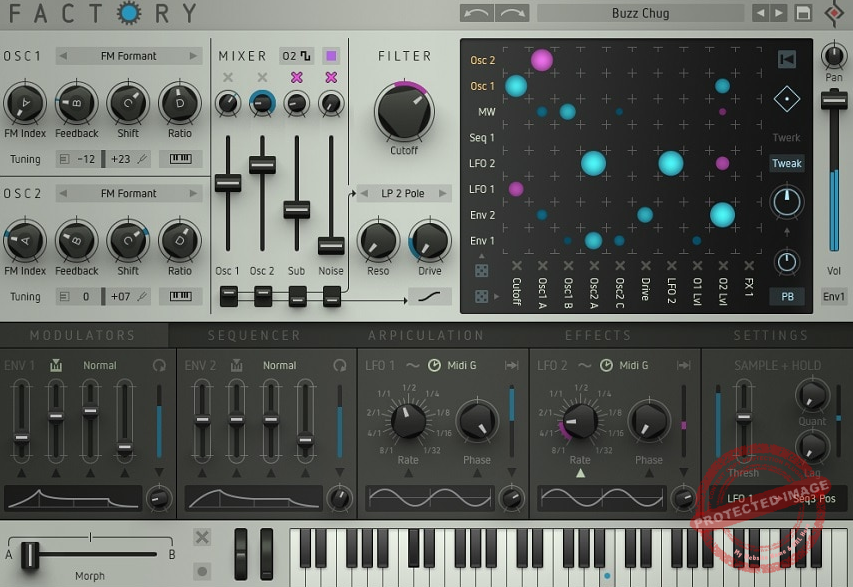
Sugar Bytes Factory is all about its vibrant, raw, and organic sound.
Let me start with its sound sources, which is a set of dual oscillators, each offering 10 unique modes like wavetable, waveguide, fractal synthesis, and even FM. It also has a sub-oscillator with ring modulation and a versatile noise generator with five color options to provide plenty of tonal variety.
- Crazy Modulations
What truly sets the synth apart, though, is the 8×10 modulation matrix. This isn’t your typical retro-style patch bay but is a flexible, modulatable system that connects 8 sources to 10 targets, unlocking 36 modulation possibilities.
But the fun doesn’t stop there. The Morph Fader lets you transition seamlessly between two completely different sound states, creating dynamic and evolving textures. You also get a Sample+Hold module with 36 curves and the ability to trigger and quantize values, and you’ve got a playground for sonic experimentation.
- The Secret Weapon: The Sequencers
Factory’s four sequencers are the unsung heroes. They can drive envelopes, LFOs, or the arpeggiator, generating intricate rhythms, sweeping modulations, and unexpected patterns. Its “Arpiculation” page was another highlight for me, combining pitch envelopes, intonation tweaks, and scale quantization to produce organic, fluid melodies.
Sugar Bytes Factory is compatible with DAWs that support VST2, VST3, and AAX plugin formats and Windows 7 or later and macOS 10.13 or higher operating systems.
17. Cherry Audio PS-20
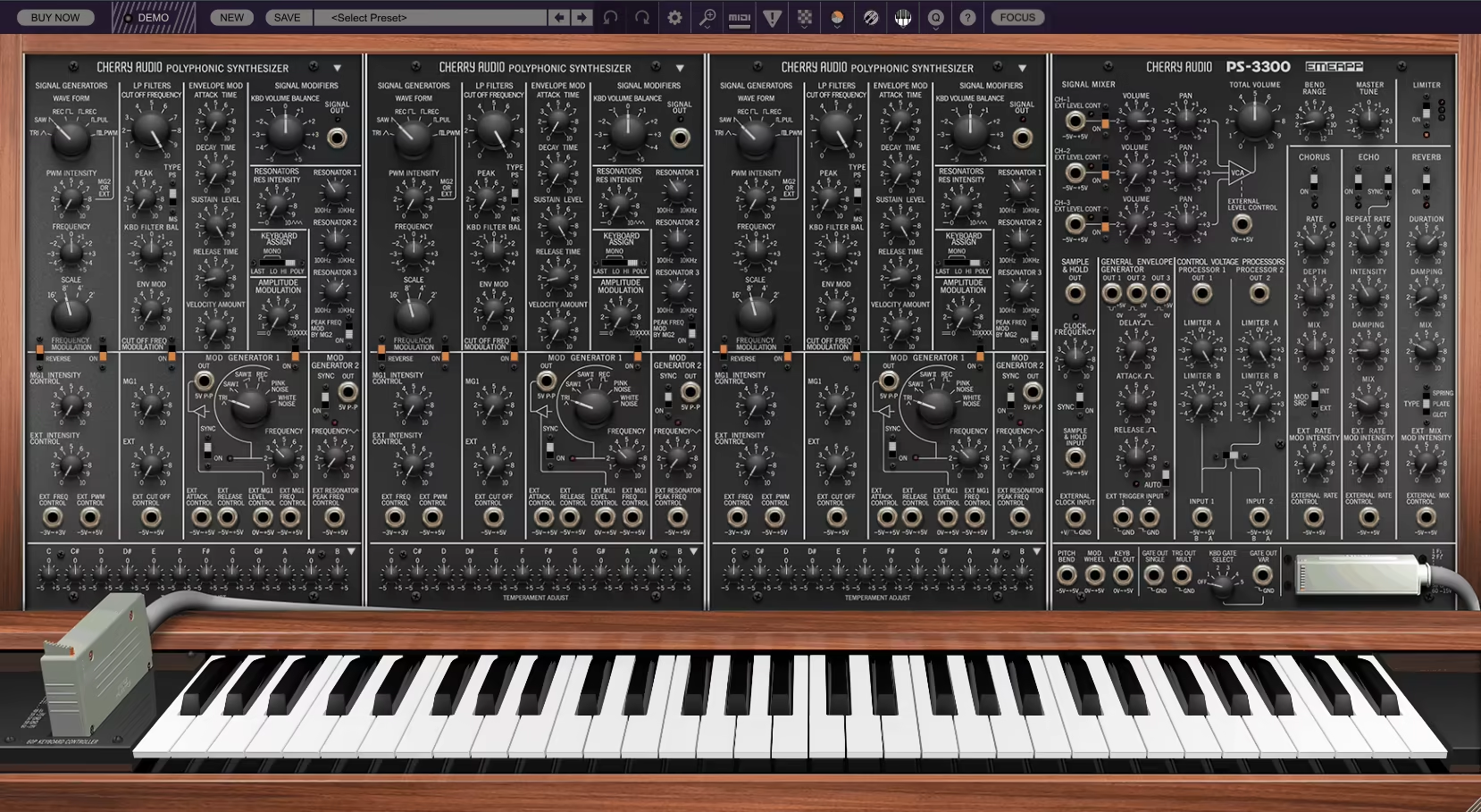
PS-20 modular plugin VST has a bold, quirky personality and immense creative potential. Modeled after the legendary Korg MS-20, this polyphonic synth delivers everything I loved about the original and then some.
First, let’s talk about the filters. The PS-20’s highpass and lowpass filters are spot-on recreations of the MS-20’s iconic sound, like those squelchy and gritty textures, capable of both subtle warmth and outright mayhem. These filters alone make it a must-have for aggressive basslines and screaming leads.
But Cherry Audio didn’t stop at recreating the past. They’ve added 16-note polyphony, so you’re no longer confined to monophonic lines.
- Patch Panel
The patch panel in the plugin has been reworked to be more intuitive while offering more input/output options, making it a playground for sound design. Whether I’m experimenting with modulation routing or using the External Signal Processor for sidechain effects, it always sparks new ideas.
- Sequencing Capabilities
Then there’s the three-layer, eight-step sequencer, which is ridiculously fun and lets you create evolving patterns, especially with tempo-syncable CV outs. Layer that with built-in distortion, mod echo, and lush reverb, and you’re crafting textures that feel alive.
Cherry Audio PS-20 is compatible with Windows 7 or above and macOS 10.13 or later operating systems and is available in AU, VST, AAX, VST3, and standalone plugin formats.
18. u-he ACE (Semi)
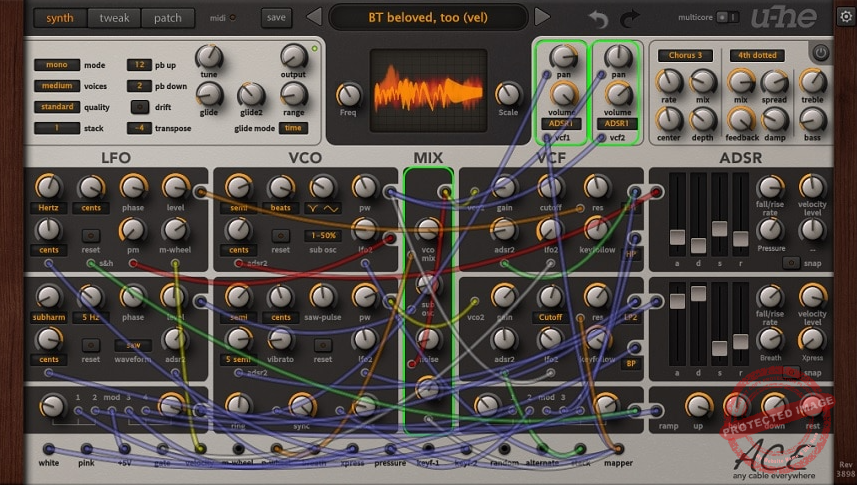
The u-he ACE (Any Cable Everywhere) synthesizer is a brilliant balance of modular complexity and ease of use, mainly because of its inviting semi-modular workflow.
ACE’s semi-modular architecture and 920 factory presets make it incredibly approachable, and its default routing is perfect for quick setups. However, the magic lies in its flexibility, so you can patch any output to any input. Whether it’s experimenting with LFOs as audio sources or creating wild FM textures by patching oscillators, ACE encourages you to explore without overwhelming you.
- High-quality sound
The analog-modeled oscillators are rich and versatile. With features like pulse-width modulation, FM, sync, and cross-modulation, they cover a vast sonic range. And if you want to push things further, the Circuit Bending options let you dial in just the right amount of analog-inspired chaos.
- Filters and Effects
The filters are beautifully modeled and can self-oscillate for extra character. I would pair them with ACE’s mapping generator, a standout feature that lets you draw custom patterns or modulate parameters per note, and you have endless ways to shape your sounds.
The effects section is simple yet effective, with chorus, delay, and bass/treble boosts to polish your patches. It also has the potential for movement with the Ramp Generator, which is perfect for adding unique modulation curves, while the Multiplex modules handle ring modulation, crossfading, and more.
u-he ACE is available in CLAP, AUv2, VST2/3, and AAX plugin formats and works with Mac OS X 10.10 or newer, Windows 7 or newer, and Linux operating systems.
19. Ableton Bengal (Requires Ableton)
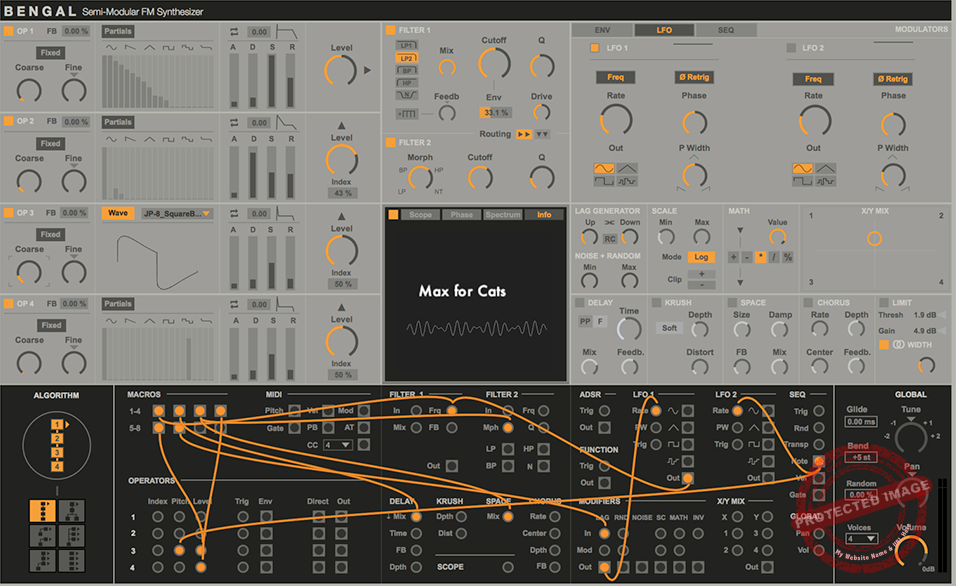
Combining the complexity of FM synthesis with a semi-modular approach, Bengal is a flexible and inspiring synth.
Bengal’s semi-modular design has a fixed structure: four operators, dual filters, and a modulation-rich architecture, but the interactive patchbay at the bottom lets you reroute signals however you like. Dragging cables between the square output and round input sockets is intuitive and opens up endless sonic possibilities.
With eight-voice polyphony, Bengal handles everything from massive chords to intricate, evolving basslines effortlessly. The four FM operators are Bengal’s heart, and they’re as powerful as they are versatile. Each operator can use editable sine wave partials or load custom wavetables (you can even drag and drop your own samples).
With independent ADSR envelopes, loopable curves, and feedback controls, creating lush pads or aggressive, metallic tones is straightforward. The six FM algorithms make it easy to experiment, offering great starting points for sound design.
- Filters, Modulation, and Effects
The synth’s dual multimode filters felt quite satisfying to work with. The first filter offers classic Moog-style Lowpass and other modes, while the second morphs smoothly between Lowpass, Bandpass, Highpass, and Notch. The ability to process them in parallel or series adds even more flexibility.
Where Bengal really shines is its modulation architecture. Two LFOs can act as FM sources, and the six-segment Breakpoint envelope is a dream for shaping evolving sounds. Pair that with the eight-step sequencer (complete with scale snapping, swing, and randomization), and you’ve got everything you need to create wildly dynamic patches.
- See and Shape Your Sound
The Visual Control Panel is one of Bengal’s most unique features. Whether you’re checking waveforms, phase, or spectrum, it gives immediate feedback on your patch. Combined with Bengal’s six built-in effects, like reverb, distortion, and stereo widening, you can tweak and polish your sounds directly within the synth.
Ableton Bengal requires you to have Ableton Live 11 Standard & Max for Live (version 11.2 or higher).
What Is a Modular Synthesizer Used For?
A modular synthesizer is used to create custom, complex sounds and textures by connecting individual modules. It's like having separate pieces of puzzles of synth (like oscillators, filters, modulators, etc.) and you putting those puzzle pieces together to kind of build your own synth and have complete control over it.
How Does Modular Synthesis Work?
Modular synthesis works by connecting independent modules like oscillators, filters, and envelopes using patch cables. Audio and control signals flow between modules, allowing you to shape and modulate sound. This setup offers endless creative possibilities.

Shaurya discovered his passion at the intersection of writing and music. Starting his career as a songwriter and rapper, he gradually picked up FL Studio and soon delved deep into the world of audio engineering and music production. Based in Delhi, India, he has worked with top studios, been featured on Red FM, garnered millions of streams on Spotify, and released music with major labels like Sony and Hitz.
